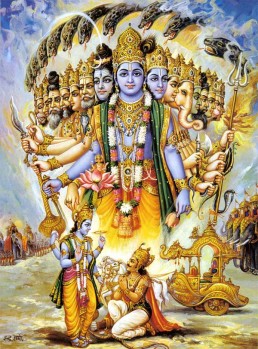Swami Chinmayananda
Swami Chinmayananda Commentary
Arjuna makes an open confession here of what he actually wishes. “I WISH TO SEE YOU AS BEFORE.” He is afraid of the Universal Form into which the Lord has expanded to express His oneness with the essence in the entire gross-world of matter.
When the Vedantic concept of Truth is thus experienced or expressed in its universal majesty and grandeur, few have the required intellectual stamina to conceive of the Totality and adore It. Even at moments when the intellect can handle such an idea, the heart of the devotee will often fail to tune up its emotion to live the Absolute-experience for long. From the mental zone, Truth can be conceived of and enjoyed only through its symbols and not directly in Its Total-grandeur.
Defining the Form of Vaasudeva in his milder-manifestation, Arjuna explains in this stanza the traditional form of Vishnu, the Lord of the Bhagavata. The concept of God as represented in the phenomena, has been described in all Puranas, as having four hands. This may look like a biological freak to students of physiology. We are apt to forget that they are figurative representations symbolising the concept of Truth. The four hands of the God-form represent the four facets of the “inner-instrument” in man.
The Lord Himself, the Self who wields these four hands is represented everywhere as BLUE in colour, and clothed in YELLOW. The significant hue of BLUE is the colour of the Infinite, and the measureless always appears as BLUE, just as the summer-sky or the deep-ocean. YELLOW is the colour of the earth. Thus the Infinite, clothed in the finite, playing the game of life through the four “inner-instruments” is the symbolism behind Lord Vishnu.
It is also interesting to note that the concept of God in every religion is the same inasmuch as He is the Supreme-most with every power and all knowledge. Man achieves things by the strength of His hands, and the Lord, who is all-powerful, can therefore be symbolised only by showing that He has four hands. The four symbolical instruments which the Lord is represented to carry in His four hands are the club, the discus, the conch and the lotus. The call of the Divine comes to everyone’s bosom, when He blows His CONCH, and if man were not to listen to the call of the Higher dictates in himself, the CLUB follows to punch him, and in spite of that, if man continues his own mistakes, the DISCUS chops him down. In case the roar of the “conch” is obeyed implicitly, then he gains the LOTUS, a flower that represents, in Hinduism, what the white-dove and the poppy-flower stand for in Western tradition. Peace and prosperity are the significance of “lotus” in India. Lotus signifies PERFECTION SPIRITUAL.
Arjuna, in short, wants the Lord to appear in his serener-Form and quieter-Attitude. For all early seekers and new initiates in Vedanta, it naturally becomes difficult to keep, in themselves, the same tempo for their philosophical pursuits. At such moments of dissipation and drowsiness of the intellect, the aspiring heart must discover some reposeful resting-place wherein it can revive itself. This bed-of-peace and tranquility, upon which the inner personality of man can revive and grow into its fuller stature, is the glorious Form of the Lord.
SEEING ARJUNA AFRAID, THE LORD WITHDREW HIS UNIVERSAL FORM; AND CONSOLING ARJUNA WITH HIS SWEET WORDS, HE SAID:
Adi Sankara Commentary
Aham, I; icchami, want; drastum, to see; tvam, You; kiritinam, wearing a crown; as also gadinam, wielding a mace; and cakra-hastam, holding a disc in hand; i.e., tatha eva, just as before. Since this is so, therefore, sahasra-baho, O You with a thousand arms-in Your present Cosmic form; visva-murte, O you of Cosmic form; bhava, apeear; tena eva rupena, with that very form-with the form of the son of Vasudeva; caturbhujena, with four hands. The idea is: withdrawing the Cosmic form, appear in that very form as the son of Vasudeva. Noticing Arjuna to have become afraid, and withdrawing the Cosmic form, reassuring him with sweet words-
The Bhagavad Gita with the commentary of Sri Sankaracharya – Translated by Alladi Mahadeva Sastry
Holy Geeta – Commentary by Swami Chinmayananda
The Bhagavad Gita by Eknath Easwaran – Best selling translation of the Bhagavad Gita
The Bhagavad Gita – Translation and Commentary by Swami Sivananda
Bhagavad Gita – Translation and Commentary by Bhaktivedanta Swami Prabupadha
Srimad Bhagavad Gita Chapter 11 – Verse 46 – 11.46 kiritinam gadinam – All Bhagavad Gita (Geeta) Verses in Sanskrit, English, Transliteration, Word Meaning, Translation, Audio, Shankara Bhashya, Adi Sankaracharya Commentary and Links to Videos by Swami Chinmayananda and others – 11-46

